
| Página principal | Quiénes Somos | Cómo Editar | Municipios de Colombia | Foro |
| Solo editores autorizados pueden realizar cambios o actualizaciones, por favor abstenerse de realizarlos, para contribuir en actualizaciones sugerirlas en contacto aquí Foro |

Introducción
Definición del problema

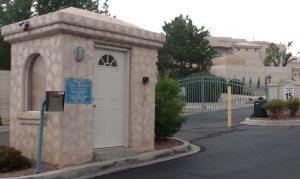
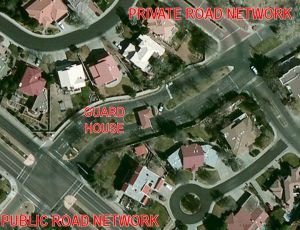
Una instalación o comunidad privada es un conjunto pequeño o grande de acceso restringido de caminos navegables regularmente conectados en uno o más puntos a una red vial pública. El ejemplo más pequeño puede ser una calle comunitaria privada protegida por una puerta. La instalación más grande de EE. UU. Es White Sands Missile Range en 3,200 millas cuadradas, más grande que el estado más pequeño de EE. UU., Que incluye caminos de tierra, calles principales y autopistas. Waze debería ser capaz de proporcionar la mejor ruta para todos. Deseamos abordar estos lugares porque muchos conductores "residentes" trabajan y viven en instalaciones privadas. Algunos "visitantes" pueden ser manejados de manera diferente. Sobre todo, debemos evitar rutas erróneas a través de instalaciones privadas para aquellos que no tienen o necesitan acceso, ya que causa un inconveniente significativo.
La restricción de acceso real en estas instalaciones o comunidades se implementa generalmente mediante puertas automáticas o guardias que solo permiten el ingreso de personas o vehículos autorizados. En casos más raros, las puertas se pueden controlar con un bloqueo mecánico de algún tipo. Un medio no tripulado para evitar el acceso en un solo sentido podría ser la tira de la llanta que desinflaría los neumáticos de los vehículos que van en una dirección. En algunos casos, el acceso puede ser sin restricciones por medios físicos, pero puede implementarse a través de patrullas, cámaras u otros medios que lleven a una respuesta para detener a un visitante no autorizado.
Una instalación privada, particularmente instalaciones gubernamentales más grandes, puede tener niveles anidados de control de acceso. Una región particular de la instalación puede ser excluida para aquellos que tienen acceso general a la instalación más grande. Ejemplos más grandes pueden tener todo tipo de carreteras, como calles principales y autopistas. Ejemplos más pequeños solo tendrían carreteras y caminos de tierra.
Si bien muchas instalaciones privadas son fáciles de mapear en Waze, algunas pueden ser bastante complejas en la forma en que representamos los puntos de acceso, creamos tipos de carreteras y usamos Lugares. Debido a esta complejidad, esta página wiki es bastante extensa. Si es un editor nuevo, le sugerimos que busque el consejo de otros antes de editar cualquier cosa excepto las Instalaciones privadas más pequeñas y simples.
Terminología
Punto de acceso: cualquier entrada o salida (generalmente ambas juntas) que conecta la red de carreteras de la Instalación privada con la red pública de carreteras. Ver Puerta' '
Puerta - Un tipo específico de "Punto de acceso" que conecta la red de carreteras de la Instalación privada con la red pública de carreteras. Existen múltiples tipos de estructuras de compuertas que se pueden editar para cualquier punto de acceso.
Majority Drivers -El tipo de conductor que accede con mayor frecuencia a la Instalación privada. Esto podría ser un residente o un visitante. Por ejemplo, uno podría decir "Los visitantes son la mayoría de conductores en esta instalación privada."
Minority Drivers - Todos los tipos de conductores que también pueden acceder a la instalación privada, pero en cantidades que son significativamente menores que Majority Drivers.
Público - El conjunto de controladores que no tienen ningún negocio para ingresar a la Instalación privada. Deben permanecer en la red pública de carreteras.
Residente - Un conductor que vive, trabaja o tiene algún otro acceso regular y autorizado a la instalación privada. Esto puede incluir el transporte público.
Visita - Un controlador que tiene algún negocio que accede a la instalación privada, pero no de forma regular. Estas personas pueden necesitar usar entradas especiales para la instalación privada. Los visitantes pueden actuar como Residentes si finalmente obtienen credenciales de acceso (código, insignia, pase, etc.).
Objetivos a Editar
Antes de editar o modificar una instalación privada, tenga en cuenta estos seis objetivos que tiene como editor de mapas para instalaciones privadas.
- Asegúrese de enrutar, entrar, salir, pero nunca a través
- Darse cuenta de que existe una diversidad de instalaciones
- Considere cómo se manejan los residentes y los visitantes
- Asegúrese de tener en cuenta las excepciones: instalaciones con reglas especiales
- Proteja su edición de instalación privada de los editores novatos
- Pon a prueba tu instalación privada
1. Enrutamiento alrededor, entrar, salir, pero nunca a través

Waze no debe enrutarse automáticamente a través de una instalación privada a menos que la fuente o el punto de destino estén dentro de la instalación. La Figura 1 muestra el concepto general de una instalación privada que está integrada en una red vial pública. En este caso, hay dos puntos de acceso. Waze debe enrutar alrededor de la instalación privada de A a B, aunque podría existir una ruta más corta o más rápida a través de la instalación. Waze también debería poder enrutar de A a C o de C a A, donde C se encuentra dentro de la instalación privada. Tenga en cuenta que Waze tampoco debe usar las carreteras dentro de una Instalación privada como una conveniencia para darle la vuelta al conductor al evitar los giros en U.

La Figura 2 muestra que algunas instalaciones privadas, generalmente más grandes, pueden tener niveles de acceso anidados. Waze debería poder enrutar dentro o fuera de una instalación privada en cualquiera de los niveles de acceso anidado sin ingresar a un área de acceso separada de un nivel más profundo. La ruta A a B ilustra este concepto. Además, Waze debería poder navegar desde un nivel más profundo de acceso anidado a cualquier otro punto, incluida la instalación privada. Las rutas entre los puntos C y D ilustran el enrutamiento dentro o fuera de la instalación privada. Las rutas entre los puntos E a F muestran la navegación entre niveles anidados. Waze también debería poder navegar bien dentro de una instalación más grande que tiene múltiples tipos de caminos.
2. La diversidad de instalaciones existente
Hay muchos tipos de instalaciones privadas que pueden representar una gran variación en los tipos de puntos de acceso, puertas y preferencias de enrutamiento para residentes e invitados. Si bien la mayoría de las instalaciones privadas son iguales y siguen un enfoque "SIMPLE", las que diseñan y crean entradas especiales y existen pueden encontrar algo nuevo para lo cual el editor tendrá que adaptarse.
Intenta mantener el diseño de tu mapa simple!
3. Considere residentes y visitantes
Este es un concepto más avanzado. Si no comprende estos problemas o no puede identificar cómo su Instalación privada trata a los Visitantes de forma diferente a los Residentes, puede seguir los enfoques preferidos o buscar ayuda de otros con más experiencia.
¿Por qué el residente vs visitante es un problema?
La respuesta fácil es que algunas instalaciones privadas tienen puertas que sirven solo a los residentes, mientras que otras sirven tanto a visitantes como a residentes. En algunos casos, una puerta solo puede servir a visitantes o residentes, pero no a ambos. Es posible que deseemos evitar el enrutamiento a una o más de estas entradas o salidas cerradas según el tipo de instalación privada y la función de esa puerta.
Debemos hacerlo a veces porque la diversidad de instalaciones privadas y el comportamiento de los residentes y visitantes es demasiado grande para estar completamente representado por el mapa de Waze. Puede que tengamos que hacer concesiones sobre cómo Waze enruta a los conductores. La discreción del editor es necesaria para tomar estas decisiones.
El objetivo principal de una instalación privada es evitar siempre que vehículos no autorizados ingresen a su perímetro. ¿Por qué? Esto sería un inconveniente para la gran mayoría, el público, porque se les daría una ruta inexacta a través de un lugar donde probablemente serían detenidos.
En segundo lugar, a los residentes siempre se les permite ingresar a una Instalación Privada, generalmente (no siempre) a través de cada puerta, mientras que a los visitantes generalmente se les permite el acceso (aunque no siempre) a través de puertas específicas. Tenga en cuenta que el "pero no siempre" hace que esto sea un tanto complejo, ya que es posible que se requiera experiencia con el material en esta página wiki, utilizando street-view y conocimiento local.
Una instalación privada con puertas que funcionan igual para todos suele ser fácil de editar. Cuando mezcle puertas de visitante y de residente, la edición puede ser más compleja para lograr un enrutamiento adecuado.
Existe complejidad adicional en ciudades turísticas, como Orlando, donde un conductor es inicialmente un visitante, pero una vez que ingresan a su tiempo compartido u otra residencia, obtienen credenciales de acceso (como el código para ingresar a una puerta desatendida) que los hacen residentes por el resto de su estancia. Los visitantes se vuelven residentes. Esto también ocurre en instalaciones militares donde los visitantes primerizos obtienen una insignia o pase para permitir la entrada a las puertas exclusivas para residentes después de su primera visita. Por lo tanto, no se puede suponer que todos los visitantes sigan siendo visitantes cada vez que naveguen por un límite de Instalación privada.
Los visitantes actúan como residentes cuando:
- Un visitante residente del host les proporciona el código de acceso.
- Un visitante se registra en la Instalación privada la primera vez y obtiene una insignia, pase o código de acceso para entradas posteriores.
¿Qué es más importante, residente o visitante?
En general, la pregunta que puede enfrentar durante la edición puede ser: "¿Para algunas puertas, el enrutamiento debería favorecer a los residentes o visitantes?"
Se ha debatido mucho sobre este tema, principalmente porque tenemos una opción y las personas tienen opiniones diferentes. Los principios reales que parecen importar son estos:
- Inconveniencia la menor cantidad de conductores.
- Determine los Majority Drivers de su instalación privada, generalmente visitantes o residentes. Si es necesario, favorezca el enrutamiento a las puertas que dan servicio a la mayoría.
- Permita que los algoritmos de enrutamiento Waze funcionen para que elija la puerta más rápida.
- Si agregamos una penalización adicional a cualquier puerta para el enrutamiento, esa penalización impedirá que esa puerta sea enrutada. Esto evita que los algoritmos de enrutamiento de Waze funcionen y viola este principio. Por lo tanto, debemos intentar evitar el enrutamiento preferencial de residentes / visitantes a menos que sea necesario. Se prefiere que todas las entradas se enruten por igual y que todas las salidas se encaminen igualmente, a menos que haya una muy buena razón para hacer lo contrario.
Considere otros factores que podrían estar involucrados en su instalación privada:
- Las grandes bases militares que usan las preferencias de los visitantes podrían encaminar la mayoría del tráfico de 1 a 100 millas fuera del camino en cada viaje. Las instalaciones privadas más pequeñas pueden encaminar una distancia más corta a algunas millas fuera del camino, pero al hacerlo arriesgan el enrutamiento forzado a través del tráfico malo.
- ¿Hay señales o guardias o ambos que pueden redirigir a los conductores al lugar correcto? Si es así, el enrutamiento de los controladores incorrectos a esa puerta puede no ser tan importante como un problema.
¿Qué instalaciones son mayoría-visitante?
Lo siguiente generalmente indica que los controladores de mayoría de instalación privada son visitantes, y por lo tanto las puertas de la Instalación Privada deberían ser mapeadas con los visitantes en mente:
Esta sección está en desarrollo.
- El tráfico es principalmente turístico.
- El tráfico es principalmente compradores.
- El tráfico es principalmente aquellos que van a lugares de entretenimiento.
Estas áreas tendrán una mayoría de tráfico de visitantes. No deseamos que estos controladores se enruten a través de puertas exclusivas para residentes.
Por favor lea el "Reglas especiales" sección de esta página wiki para obtener información adicional sobre otras áreas de visitantes y mayoría que se manejan de manera diferente.
Which Installations are Majority-Resident?
The following usually indicates that a Private Installation Majority Drivers are residents, and therefore the Private Installation gates should be mapped with residents in mind:
This section is under development.
- Most military bases that have living quarters and workers (both are residents).
- Most government installations.
- Most private communities.
The number of people commuting and trips driven to these Private Installations by residents far exceeds that from visitors.
4. Exceptions: Installations with Special Rules
Please read the "Special Rules" section of this wiki page for additional information.
In particular, there are a number of visitor-centric Private Installations that should not be mapped or should be mapped differently than the procedure described for Private Installations. These include:
- Airports
- Theme Parks
- Paid Parking Lots
5. Protect Private Installation Editing
Work that you put into making a Private Installation route property can be easily damaged by novice editors. Your editing efforts should be locked at a high enough rank to prevent novice editors from damaging the routing, yet allow them to edit non-critical roads.
It is quite easy to damage routing onto a Private Installation, particularly larger installations that have many road segments close to the public road network.
Because of the complexity of this topic and the resulting editing, it is suggested all roads around gates and other areas (described below) be locked at Rank-5. Alternatively, they can be locked at a lower rank agreed upon by local Area Managers, State Managers, Regional Coordinators, or Champs. Check US state pages and other locations for guidance. If you cannot lock to the agreed level, request help from a higher-ranking editor.
What should usually be locked?
- All gate road segments that control routing onto or off of the Private Installation.
- This includes BLOCKED gates so that they are not reconnected.
- Road segments around the perimeter of the Private Installation that you notice are accidentally connected by novice editors. If it happens once, it will happen again!
- Road segments around the perimeter that look like they may be connected on the aerial images, but are really blocked by fences or other structures difficult to see on the aerial.
- Area Places over gates.
6. Testing Your Private Installation
Significant testing has been performed to create this wiki content. This includes testing on actual private installations of various types and discussed in the Waze Forum. It is suggested that you test your Private Installation edits because mistakes can be easily made and routing not work as you intended. Here are some suggestions of how you may accomplish this after you make edits.
- Monitor that area for User Reports.
- Test routes in Live Map to ensure no through-routing and good on/off installation routing.
- Test routes in client by setting various "from" and "to" destinations without having to drive.
- Test drive.
- Navigate between two distant points outside the private installation to ensure no through-routing.
- Navigate from outside to inside the private installation, drive around the outside of the private installation and ensure rerouting occurs to the logical nearest gate.
- If you have access to the private installation, repeat the above by by driving around inside the installation.
The underlying logic - PENALTY
Understanding regular/private segment penalties is the key to understanding how to edit a particular Private Installation.
Penalty: Background
Waze uses a routing penalty system to control traffic flow. This approach for controlling traffic into and through private installations depends upon that routing logic. When a Private or Parking Lot segment is used on the map, the Waze routing server places a routing PENALTY when transitioning from a Private or Parking Lot segment to any non-private or non-parking lot segment, including transitions from Private to PLR or vice versa. When a destination is a parking lot, there is no PENALTY to reach the parking lot. However if the destination is on the far side of a parking lot on a standard street, Waze will try to avoid driving through the parking lot to get to the street on the other side. The same is true for private segment types.
Penalty: Private Installations
Private Installation editing uses PENALTY with private road segments to prevent through-routing and control which gates have preferred routing. It is also used to control exit routing so there is typically no preference for an exit other than directed by standard Waze algorithms.
Private segments only add a penalty in transitioning from a private to another road segment type. There is no extra penalty going from one private segment to an adjacent private segment. So, for the purposes of Private Installations, there is usually no need to connect two private segments together at a gate.
| Note that a single private segment transition for a Private Installation has enough PENALTY to cause Waze to route hundreds of miles to the next entry segment that is not private or that has fewer private-regular street transitions. Therefore the penalty of a private segment is so extreme it is almost absolute as compared to other routes. |
On this wiki page we may use multiple private/regular street segment combinations to increase penalty. For simplicity on this wiki page, will just add up the number of private/regular street transitions to count the penalty for any given path, such as across an access point or gate.
Penalty Nomenclature P(in), P(out)
To be more clear on this wiki page, we will use the following nomenclature for penalty. Here are examples:
- P(in) = 1
- Penalty going into the Private Installation equals 1.
- P(out) = 0
- Penalty going out of a Private Installation equals 0.
P(in) is the lowest penalty entering a Private Installation. For example, if there are three gates to a Private Installation having penalties of 1, 2, and 3, then P(in) for that Private Installation is P(in)=1, the least of all penalties. This is because Waze will route only to those gate entrances that equal P(in) and will never route to gate entrances with penalties greater than P(in).
Similarly, P(out) is the lowest penalty exiting a Private Installation. Waze will route only to those gate exits that equal P(out) and will never route to gate exits with penalties greater than P(out).
How to Calculate and use Penalty
Each transition from private to other regular road type adds a penalty of one. Private-Street has a penalty of one. Private-Street-Private-Street has a penalty of two, and so on. Pathways with no private segment have a penalty of zero.
- Calculate the penalty at each entrance route. P(in) for the Private Installation is the smallest number from all entrance routes.
- Calculate the penalty at each exit. P(out) for the Private Installation is the smallest number from all exit routes.
- No entrance with a penalty greater than P(in) will ever route. If more than one entrance exists equal to P(in), they will route based upon Waze's routing algorithms.
- No exit with a penalty greater than P(out) will ever route. If more than one exit exists equal to the P(out), they will route based upon Waze's routing algorithms.
Penalty: Preferred Approach
The preferred approach for most Private Installation gate penalties is this:
- A Private Installation should have P(in)=1 or greater, and all gates should have the same penalty.
- A Private Installation should have P(out)=0 or greater, and all gates should have the same penalty. If P(out)=0, then exit roads must be one-way road segments.
- Entry and exit penalties do not have to be the same.
If this approach is followed, then all gates will be routed equally in a way that uses Waze's route optimizing algorithms. If any gate entrance has a higher penalty than other entrance gates, it will never be routed. If any gate exit has a higher penalty than other exit gates, it will never be routed.
Penalty: Alternative Approaches
There may be times when you never want to route to a particular gate, even though some residents or visitors might be able to use it. In these cases, you should use a Specialty Gate with a higher penalty. We prefer to map using a Specialty Gate rather than disconnecting road segments because we wish to avoid creating Map Problem Reports when Waze sees a Wazer drive this path. You may wish to do this in the following instances:
- When a special gate exists but you never want to route to it.
- Example: A "Contractor Gate" on a military base.
- Example: A "Restricted Gates."
- When you wish to add penalty to any visitor or resident gate such that it is never routed.
- Example: For gates serving only Minority Drivers, you may, at times, wish to prevent routing.
- Example: If residents are Minority Drivers, you may, at times, wish to restrict all gates that serve only those residents.
- Example: If visitors are Minority Drivers, you may, at times, wish to restrict all gates that serve only those visitors.
Places / City Names for Private Installations
Should a private installation be marked over it's entire area as a Area Place Area (landmark)? Not always. Very small private installations can be marked by a Area Place over their entire area if it serves a purpose.
This does not make sense for larger private installations that might have other Places within them or that are actually cities. For these larger installations, use the city field of all street names to name the private installation.
Specific guidance about Private Installations use of Places or City Names:
- Does the state DOT consider it a city? If so, then use City Names in each street to identify the installation.
- Does the US Post Office consider it a city with it's own zip code? If so, then use City Names.
- Does the local community consider it a city like entity? Then maybe it should have a City Name if it is large, or an Area Place if it is small.
- Is it large enough that an overall Area Place on the Private Installation would obscure finer detail Area Places below? If so, use City Names. If not, use an Area Place to denote the Private Installation.
What smaller Place should be included within a larger private installation? We should generally follow the rules that are set for Places in cities and areas. In addition to these, you might also consider marking the following as Places because they are critical navigation and destination points:
- Entry/Exit gates (Place Area)
- Visitor Centers (Place Area)
- Museums and other similar destinations the installation may maintain
- Memorials
- Parade Fields
- Items locally useful for navigation
You should avoid mapping Places that are specific to private or military uses on a private installation. See the Places Wiki Page for specifics about using an Area or Point for these items.
Gate Editing Options
This section explains techniques and options for editing different types of gates you will encounter in Private Installation access points.
These gate editing options will be used separately or combined in following sections that describe how they are applied for SIMPLE and COMPLEX Private Installations.
We will consider these types of gates:
- BASIC - single two-way road segment
- STANDARD - two, one-way road segments
- SPECIALTY - a more complex, modified STANDARD gates
- BLOCKED - a gate that is almost always closed
Gates: Common Best Practices
- Every entrance road in a Gate to a Private Installation must have at least one type of penalty that is either a "private road" segment or a one-way exiting road segment. If this is not done, the map does not reflect the reality of the actual road and has the possibly of routing public traffic onto the Private Installation. This may be due to Waze attempting to turn around a driver using roads within the Private Installation. In this case Waze is routing through the Private Installation by traveling onto then off of the instillation.
- All the segments used in a gate must be at least 5 m (16 feet) long. Check the house numbers. If they are supposed to be inside the installation, make sure they are not on any of the gate segments.
Gate Option: BASIC Gate
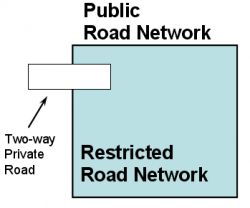
A "BASIC Gate" is an access point represented by a single short two-way private road segment.
BASIC Gates have a PENALTY of 1 in both directions.
BASIC Gates are often useful for smaller Private Installations, particularly those with just one or a few access points with simple road structures that would make a STANDARD Gate burdensome to use on the map. Examples include smaller private residential areas with automated gates.
Benefit of this type of gate is that it is more structurally simple than the STANDARD Gate. Detriments of this type of gate is that it does not allow any road type but "private" to be used and it cannot represent more complex gate geometries often seen at larger Private Installations.
A BASIC Gate effectively isolates the entire installation from the public road network unless a route begins or ends within the installation. The private road segments and surrounding roads should be locked with a high enough level lock to prevent novice editors from deleting or changing this control.
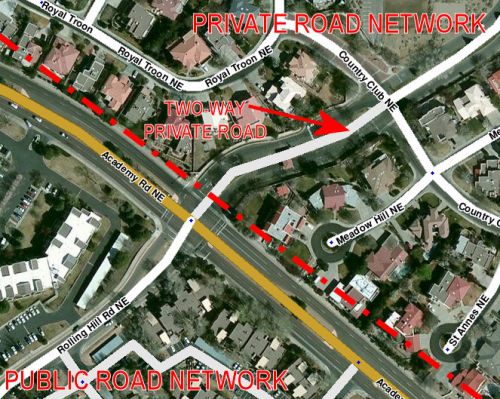
| Warning. Do not mix BASIC and STANDARD gates in the same Private Installation. Doing so will cause incorrect exit routing preferred through the STANDARD gates. For a solution, see MODIFIED STANDARD Gate. |
Gate Option: STANDARD Gate
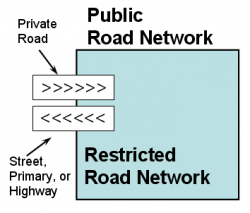
A "STANDARD Gate" is an access point represented by a one-way split road entering and exiting the installation. The entering one-way road will include one private road segment. The exiting one-way road will be of one segment using the appropriate type of that road (usually street, primary street, or minor highway). This structure often mimics the actual lane geometry for such installations. In addition, exit lanes from private installations are usually not restricted. That is, anyone within the private installation can exit through a gate without credentials or a code to open the gate.
STANDARD Gates have a PENALTY of 1 going onto the installation and a PENALTY of 0 exiting the installation.
STANDARD Gates are useful for moderate to large-sized Private Installations. This is particularly true where the access points have guard booths, turn around streets, and other structures that would make it hard to use BASIC Gates.
A primary benefit of this type of gate is that it can accommodate complex gate road structures such as turn-arounds and wider areas between the entering and exiting roadways. It can also allow the exiting segment to be of the same type as the road network on either side, for example, a primary street. A detriment of this type of gate is that it is more complicated than the BASIC Gate.
A STANDARD Gate effectively isolates the entire installation from the public road network unless a route begins or ends within the installation. All the gate road segments and surrounding roads should be locked with a high enough level lock to prevent novice editors from deleting or changing this control.


| Warning. Do not mix BASIC and STANDARD gates in the same Private Installation. Doing so will cause incorrect exit routing preferred through the STANDARD gates. For a solution, see MODIFIED STANDARD Gate. |
Gate Option: MODIFIED STANDARD Gate
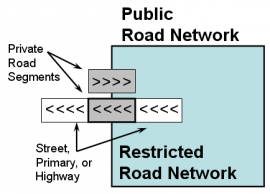
As an advanced topic, one can create a "Modified Standard Gate" that has a different exit road configuration. The exit road would be the standard one-way street, but at least one segment of that path would be private.
MODIFIED STANDARD Gates have a PENALTY of 1 going onto the installation and a PENALTY of 1 exiting the installation.
Why would you use this configuration? Geometry of some gates may require separate entry and exit roads. This makes use of a Simple Gate more difficult because a Simple Gate uses just one two-way segment. The most important reasons is that MODIFIED STANDARD Gates can be mixed with BASIC Gates and still have all gates with the same entrance penalty and exit penalty.
Gate Option: SPECIALTY Gates
This section will consider gates such used to divert very specialty, usually lower-volume traffic at locations including larger military bases and smaller residential communities.
SPECIALTY Gates are those that are usually (but not always) represented with both entry and exit penalty higher than other gates, and thus will never be routed. Instances will be listed here to aid editors in considering their use.
Note that while these gates will never be routed, this is acceptable because they service a much smaller amount of traffic than other resident/visitor gates. Allowing Specialty Gates to have the same penalty as other gates would cause erroneous routes for the majority of traffic. This would result in poor performance for the majority of Wazers.
You may encounter other SPECIALTY Gates, but the ones covered here are:
- Contractor / Deliver Gate
- Restricted Gate
- Resident-only Exit
Specialty Gate: CONTRACTOR/DELIVERY Gate
A "Contractor/Delivery Gate" is one where specialty traffic is routed, primarily on military bases; however, a commercial campus may have an equivalent "delivery entrance" or "construction vehicle entrance" controlled by guards. These gates exist primarily because special inspections or approval must occur for those going to these gates. If this traffic were to be processed at normal gates, the activity would block and delay higher-volume resident/visitor traffic. Standard residents and visitors are usually rejected or turned around at these access points and not allowed to enter or exit at these locations.
Note that those using a Contractor/Delivery Gate may themselves be residents or visitors. They must use this gate for a special purpose.

Note that some Private Installations have a Contractor or Deliver Gate merged with a regular visitor/resident gate. In these cases, use a BASIC or STANDARD Gate. You can recognize these because there is usually a pull-off area where inspections occur for deliveries or large vehicles.
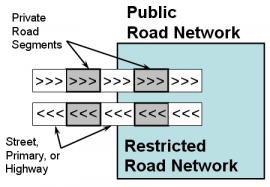
These gates should have a higher penalty than other gates to prevent all entry/exit routing of traffic by Waze. Typically this is done with a private-street-private-street set of segments, or more if required. If possible, use a set of two-way set of road segments. Exact geometry is left to the local editor based upon the structure of the actual roadways. Many options are possible. Make sure to count entry and exit penalties separately and ensure they are at least one larger than other gates.
Specialty Gate: RESTRICTED Gate
A restricted gate is one that has highly restricted traffic flow for residents only. Examples could include a chain link fence closed with a padlock that must be manually opened by residents with a key. The amount of traffic is going to be low because of the manual operation, and therefore this will be a part of Minority Drivers. Editors should not allow routing at these locations because Waze cannot determine which drivers have access and any allowed routing would inconvenience the Majority Drivers.
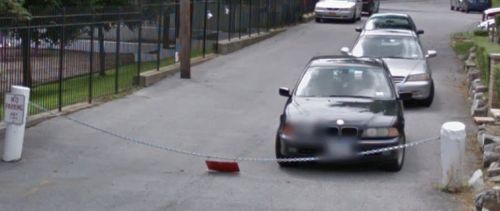

These gates should usually have a higher penalty than other gates to prevent all entry/exit routing of traffic by Waze. Typically this is done with a private-street-private-street set of segments, or more if required. Because traffic can usually go either way once the gate is opened, the preference is to use two-way road segments.
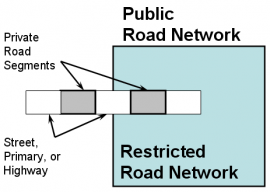
RESTRICTED Gates should have an PENALTY that prevents routing. Typically this is a penalty of two or more.
An alternative treatment is to use a Blocked Gate rather than a Restricted Gate. We prefer not to do this because a Wazer going through one of these gates would tend to generate a Map Problem Report indicating a road segment was missing.
Another alternate treatment is when a Private Installation is comprised of only restricted gates. In this case, one can model all these gates with SIMPLE gates because they are the same.
Specialty Gate: Resident-Only Exit
Definition: Resident-only exits are those that require a transmitter, a badge swipe, or some form of ID shown to a guard to exit. Visitors are not allowed to exit resident-only exits. Usually this type of gate is used for added security or loss-prevention.
Resident-only exits appear to be fairly rare in Private Installations, but they can exist. Typical Private Installations allow anyone inside to exit without inspection either because guards don't check exiting traffic or a vehicle can pull up to a gate and the gate opens automatically for everyone.
Because Resident-Only exits are rare and usage is likely very local, it is difficult to provide a common approach. It is therefore left to local editor discretion to decide how to handle these gates. Two general options exist. You should pick the one that negatively impacts the fewest drivers.
- Edit an exit penalty equivalent to all regular gates. This will route drivers to this exit based upon Waze algorithms, typically favoring the resident. Visitors routed here will have to find a different exit.
- Edit an exit penalty higher than most gates. This will block these exits from ever being routed. This will favor the unknowing visitor by making sure they are sent to a visitor-friendly gate, but prevent Waze routing algorithms from ever using this exit for residents.
Gate Option: BLOCKED Gates
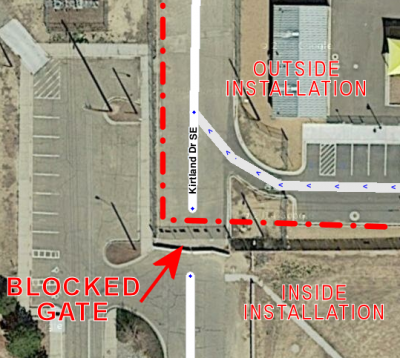
A BLOCKED Gate is an access point that is usually closed. They are opened infrequently by few individuals.
BLOCKED Gates have an infinite PENALTY as they cannot be routed.
BLOCKED Gates exist on small and large Private Installations. A small installation may use a BLOCKED Gate to allow access to service, repair, or construction vehicles that infrequently visit the installation. Larger Private Installations will likely have more of these BLOCKED Gates that exist to allow special infrequent traffic.
BLOCKED Gates might be closed with chains, chain link fences, various types of gate structures that can open and close, and even concrete barriers. They might be used very infrequently or daily by a small set of residents.

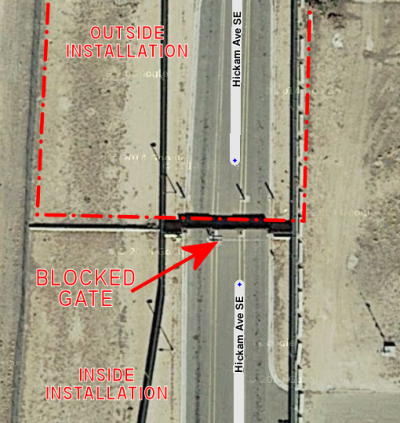
Because these access points are usually closed, we will represent them on the Waze Map as disconnected road segments that permanently disallow traffic flow. It is not worth trying to allow the infrequent traffic that would move through these gates because we have no way of knowing when they would be open. Inconvenience to the majority of Wazers could be extreme.
The surrounding segments should be locked at a rank high enough to prevent lower-level editors from reconnecting the road.
BLOCKED Gates can be used as needed in any SIMPLE or COMPLEX Installation without restriction because they disallow all traffic at all times.
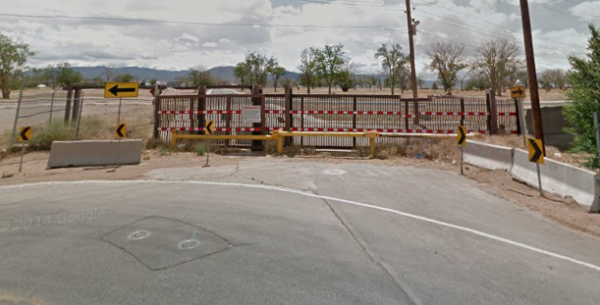
Editing Approach - SIMPLE/COMPLEX
If you are familiar with editing Private Installations, this section is not required. it is included here to provide advice and suggestions to those new to Private Installations.
Because there are so many different types and variations of Private Installations, we organize them here in two categories - how they might be approached by editors. The two categories and their characteristics are:
- SIMPLE Private Installations
- Contain one type of gate at one or more access points.
- Penalties for all entry pathways are the same.
- Penalties for all exit pathways are the same.
- Primary editing focus is to prevent the public from routing through the Private Installation.
- Are fairly easy to edit.
- COMPLEX Private Installations
- Contain two or more types of gates at multiple access points.
- Resident-only gate
- Visitor/Resident gate
- Specialty gate (such as contractor gate, restricted gate, etc.)
- Penalties for entry pathways may not be the same.
- Penalties for exit pathways may not be the same.
- Strong potential for inaccurate routing if gates are not configured properly.
- Likely no perfect solution for all types of drivers (Resident, Visitor, Special-purpose)
- Contain two or more types of gates at multiple access points.
Common Best Practices
- Do not disconnect roads to alter routing into Private Installations because this does not reflect reality in the road system, impacts residents that can enter any gate, and stops people from routing out of the Private Installation. The only time this is done is when the road is really closed all or most of the time. See the section on Locked Gates.
- Do not make all roads within a Private Installation "private roads." This does not reflect reality, has been found to cause routing errors in Waze, prevents use of a diverse set of gate types, and prevents nested Private Installations. Because this was an accepted practice in the past, you may need to alter prior work like this.
- Test your Private Installation. Test in Live Map. If possible, drive-test your Private Installation or seek help from a local resident. Information about testing your editing is contained elsewhere on this page. Such testing can help you find rogue connections and errors in gate treatment on the map.
Editing SIMPLE Private Installations
This section explains how to edit SIMPLE Private Installations.
Definition - Simple Private Installations
Simple installations are those private communities, military bases, and other installations with only one type of gate treatment for one or more access points. Access points may include only one of the following and as many BLOCKED gates as needed:
- BASIC Gates
- STANDARD Gates
Typically these attributes might indicate an installation is Simple: (a) only one access point, (b) for multiple access points all gates are the same. The size of the Private Installation does not matter. The largest Private Installation in the USA, White Sands, is a Simple Private Installation.
The editor's primary focus is to prevent the public from routing through the Private Installation. Secondary focus is to have all exit penalites the same and all entry penalties the same so that Waze routes users based upon nearest gate and traffic conditions.
Examples
- Small gated/private community
- Gated country club with smaller area
- Private school
- Small closed commercial campus
- Simple Military sites (e.g., National Guard armories), usually those without SPECIALTY Gates.
This does not include paid parking lots and other parking facilities. These are to be mapped with parking lot roads. See the Special Rules section below.
SIMPLE Installations: Preferred Editing Approach
Every access point must be of the same type of gate, either all BASIC or all STANDARD. One cannot use a mixture of these two gates because routing out of the Private Installation would always favor STANDARD gates no matter where the driver was located.
It is suggested that you separately count the penalties at each gate for exiting and entering. For the Private Installation to route properly, (1) All entry penalties should be the same for every access point or gate and (2) all exit penalties should be the same for every access point or gate.
BLOCKED Gates are always allowed editing a SIMPLE Installation because they do not alter routing behavior.
By definition, other gate types, like SPECIALTY GATES, are not defined for a SIMPLE Installation. This would make it a COMPLEX Installation.
Note that it is permissible to use BASIC gates at locations where guard houses are located if the entry and exit roads are one and the same or very close together.
Area Places
Because visitors may be routed to resident-only gates in this approach, editors should consider placing a sufficiently large Area Place over each visitor gate and naming it. In this way a visitor would have the option of routing to the appropriate gate (via the Area Place) to which their host directs them or they otherwise know to travel.
Editing COMPLEX Private Installations
This section explains how to edit COMPLEX Private Installations.
Definition: COMPLEX Private Installations
Complex Installations are those private communities, military bases, or other installations that have more than one gate treatment for multiple access points. Access points in the installation may include one or more of the following:
- BASIC Gates
- STANDARD Gates
- SPECIALTY Gates
- BLOCKED Gates
Complex Installations may have other key attributes. They large enough that there is some reason to have primary streets or highways. They are also more likely to have multiple levels of access control (installations within installations). Specifying exact size is not effective because of significant variation in these installations.
Typically these attributes might indicate an installation is large: (a) more than 20-30 roads, (b) secondary roads or highway streets needed.
Moderate sized installations between "smaller" and "larger" will exist and discretion of the local editor should be considered.
The editor's focus is (A) to prevent the public from routing through the Private Installation, (B) ensure basic accurate routing for the majority of drivers, and (C) decide how to handle different routing for residents, visitors, and special-purpose drivers.
Examples:
- Larger Military base
- Larger Government sites
- Huge hunting lodge and hunting grounds, ranches, etc.
- Large closed commercial campus
- Large country club or private communities with multiple entrances
Private installations covered by this article do not include airports or theme parks. See the "Special Rules" section of this wiki page for information concerning roads in these locations.
COMPLEX Installations: Preferred Editing Approach
It is recommended that, just like SIMPLE Installations, most access points be of the same type of gate, either all BASIC or all STANDARD; however, other gate types can be added if they produce the desired routing behavior. Typically delivery and contractor gates (SPECIALTY gates) should have an entry and exit penalty one higher than all other gates so that no resident or regular visitor is routed in or out of these gates. This is because traffic volume using delivery and contractor gates is very small.
BLOCKED Gates are always allowed editing a COMPLEX Installation because they do not alter routing behavior.
One approach to consider is this:
- Use BLOCKED gates for all those gates permanently or semi-permanently closed.
- Use a SIMPLE Installation approach at first so all remaining gates are routed equally.
- Identify contractor or delivery gates. Using SPECIALTY gates, make sure that the entry and exit penalties of these gates is at least one higher than all other gates so they are never routed.
Special Topics: Larger Private Installations
A. Public Roads Across Private Installations
Many larger military bases and perhaps other private installations sometimes have long right-of-way permissions for a publicly accessible road, often times this is a highway or primary street. (e.g., US-70 through White Sands Missile Range.) These highways run across the private installation with no restriction to traffic but provide no access to the installation itself. Editors should not create any access restrictions in these regions. Because these roads are often times fenced off on both sides from the private installation, editors should be on the look out for private installation roads inappropriately connected to the public road. These are usually locked off by gates most of the time, in which case the road can be disconnected or have a gap. Some of these are entry/exit gates with treatments noted above.
B. Preventing Other Editors from Making Mistakes
One method of preventing mistakes from novice editors has already been discussed, locking of the private road segments and surrounding segments. There is another approach that may be valuable.
Larger private installations, such as a military base, that are embedded in a city often have legacy roads that used to connect to the public road network. From the Waze Editor aerial images, it can look like these roads actually connect to the private installation, when upon closer inspection (if possible) there is really a fence that permanently blocks the road. There may also be a fence gate that is closed most of the time, only opened when guards are present. In both these situations, there should be no road connection, or a gap in the road network within the Waze Editor.
Novice editors or experienced editors that are not paying attention, may accidentally connect these roads when they should not be connected. One should lock these segments. One may also put a signpost only available to editors noting this issue. Until Waze implements signposts for editors, one may use Live Map to inert a Problem Report at the location, then go back to that report in the editor and enter a note such as "Do not delete this report. Fence gate at this location is always closed." This should alert and remind editors that the roads should not be connected.
C. Gate Closures and Restrictions
Many larger installations will have access/entry points or gates that have limited hours or that are closed on certain holidays. Utilize Scheduled Restrictions in the editor to allow Waze to know when to route through a particular gate. These are typically not turn restrictions, but restrictions on traversing a segment. Some gates can be very isolated on larger installations so routing may navigate someone 10 to 30 minutes to a closed gate.
When doing this, enable Scheduled Restrictions for only one segment in each direction to reduce editing errors and maintenance. This segment should be the private road segment on the inbound direction (or the single two-way private segment). For entry points with a one-way outbound regular road type, it should be the segment adjacent to the private inbound segment. Scheduled restrictions would usually be the same on these two segments unless the private installation has differing entry and exit policy.
You can find the hours of gates or entry points through the private installation website or by calling the appropriate private installation authority.
D. Area Places for Access/Entry Points
Entry points for larger government Private Installations are typically named such as "North Gate" or "Maxwell Gate." These are Area Places that are useful for those using Waze to understand their location relative to the Access Point. It is suggested an Area Place of type "Professional and public" then "Government" be generated over the larger region of the Access Point and named with the short name of that Access Point. Do not make the Area Place just the size of the guard houses or other features. Make it large enough to encompass the area so that it is easily seen on the Waze client.
If you do not know the name of the Access Point for government Private Installations, do not create an Area Place. Names of Access Points may be known locally or found on on a website about the private installation.
Because visitors to residential Private Installations may be routed to resident-only gates in the preferred approaches, editors should consider placing a sufficiently large Area Place over each visitor gate and naming it. In this way a visitor would have the option of routing to the appropriate gate (via the Area Place) to which their host directs them or they otherwise know to travel.
Additional information about Places is in the Special Rules section.
Installations with Special Rules
These "installations" are called out for special rules because they are similar to private installations but are handled differently than guidance on this wiki page.
Paid Parking Lots
Most drivers to these facilities are "visitors." There is usually no strict access control other than penalty for not paying or obtaining some kind of entry ticket. Control is often exercised at exits where drivers must pay.
Paid parking lots and other parking facilities are to be mapped with parking lot roads, and not according to the Private Installation rules defined in this article. See Best map editing practice#Parking Lots.
Airports: Rental Car Lots
Airport Rental Car Lots have different type of access control but are very similar to Paid Parking Lots. There is usually no entry access control, but there is exit access control.
Rental car lots and other parking facilities are to be mapped with parking lot roads, and not according to the Private Installation rules defined in this article. See Best map editing practice#Parking Lots.
Airports: Air-side Roads
Most drivers to these facilities are "visitors."
Do not map the private, restricted-access roads on airport grounds at all. Map airport roads which are accessible to the public (terminal pick-up/drop-off roads, parking lot access roads, etc.) as public roads, not as private installations.
Airports have "air-side" restricted road networks that allow traffic for baggage carts, service vehicles, airplane fuel tankers, etc. While it may be tempting to map this road network either as an isolated set of roads or with provisions cited elsewhere in this document for Private Installations, this should not be done. Here's why:
- A large number of people use Waze to navigate to airports. The particular search service or function that returns a GPS coordinate to Waze may be in error, placing the destination marker nearer to the air-side private road network of the airport than to the public airport roads. This could lead to an incorrect route or even an impossible-to-reach destination, which would frustrate the traveler.
- The private air-side road network of an airport tends to be both close to and accessible from the public road networks around the airport and therefore is more prone to this navigation error.
- Very few people use the private road network of an airport, relative to the great number that use an airport's public access roads. To those that have requested this function, we apologize. The benefit of doing this for few would likely inconvenience many. We suggest routing to the nearest spot to your destination (i.e., the gate) on the public road network.
In some cases, military bases hold public airports. In such situations, some discretion and creativity may be needed to decide which roads on the airport should not be mapped and which on the military base should be mapped. Usually there is a second perimeter around the airport separating it from the base.
Theme Parks
Most drivers to these facilities are "visitors." While many parking lots are accessible by anyone, some require payment to enter. For very large Theme Parks like those around Orlando, some access roads may be used by locals as well as visitors and therefore should not be private.
Publicly accessible roads in a theme park, even after a pay-station/gate, are to be mapped with parking lot roads, similarly to other paid parking lots. Furthermore, be careful with mapping the "backstage" private roads which are only to be used by employees. It may be wise to not map these roads, similarly to "air-side" airport roads as described in "Airports" (but to a lesser extent), so that routes are given to the public entrance of the theme park facility.
Military Bases and Government Installations
See Military Bases for proper editing on a military base.